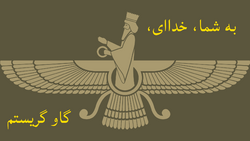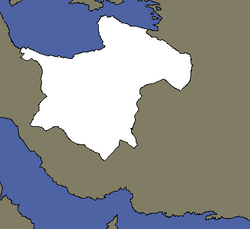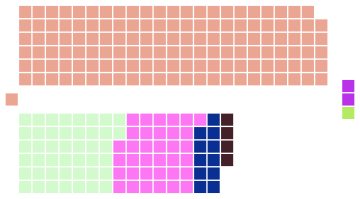| مزدستان | |
|---|---|
| Mazdestan | |
| Flag of Mazdestan | |
| General | |
| Name | Mazdestan |
| Capital | Tehran |
| Largest City | Tehran |
| National Abstract | |
| Map of the Republic in 2152 | |
| Government | |
| Government Type | Theocratic Republic |
| Head of State | Moabadan-Moabad Yousef Farrokhzade |
| Head of Government | President Darab Shamshiri |
| Legislature | People's Parliament |
| Judiciary | Grand Court |
| Demographics | |
| Demonym | Persian |
| Population | 1,418,513 |
| Official Language | Farsi, Avestan |
| Spoken Language(s) | Arabic; Pashto; Turkmen; Kurdish; Lurish; Gilaki; Semnani; Mazenderani; Assyrian; other |
| Ethnic Groups | Persian; Azerbaijani; Turkmen; Kurdish; Arab; Afghan; other |
| Official Religion | Zoroastrianism |
| Major Religions | Islam; Judaism; Mandaeism |
Mazdestan (مزدستان mazdestan), also the Persia or Iran, formerly the Zoroastrian Republic of Old Persia, is a theocratic republic situated in former Iran, at the heart of the Inland Sea and south of the Caspian Sea. The Republic is officially Zoroastrian, though few restrictions exist on other religions in the nation, with the Moabadan-Moabad as the head of the Zoroastrian church and the head of state. The country is composed of twenty provinces divided into six regions, each of which is lead by a Rahbar. The nation is internally considered to have been founded in 2042 with the Zoroastrian Uprising. The capital is Tehran, the old capital of Iran and former Persian Empires and a city which dates back to ancient history.
History[edit | edit source]
Early Post-Flood[edit | edit source]
Immediately following the collapse of Iranian society, various Islamic groups began asserting control over the different regions. Amongst these, the Islamic Tribe of Al-Madina in Yazd contained a large number of followers of Zoroastrianism, drawn to Yazd Atash Behram, the Zoroastrian temple containing the last of the Atash Behram, or "fires of victory". Relations between the two groups were strained due to the sacking if Pir-e-Naraki, an important Zoroastrian site. Finally, tensions reached breaking point with the extinguishing of the Atash Behram and the destruction of the Yazd Atash Behram.
Zoroastrian Uprising[edit | edit source]
In 2042, the Zoroastrian population of Al-Madina rose up under the leadership of Kiaan Singh as a direct result of "Muslim affronts against the Zoroastrian religion". What began as scuffles across the city erupted suddenly into a full-blown conflict on the eve of October 15th, 2042.
Post Revolution[edit | edit source]
Following the Revolution, now Leader Kiaan Singh began to consolidate Zoroastrian control of the city, banishing remaining Muslims and executing those once a part of Al-Madina's government.
Muslim Reconquest[edit | edit source]
As Zoroastrianism spread across former Iran, Muslim leaders in the west began surgical strikes intended to remove leaders of government and priests. This spurred Zoroastrian interests in the west, leading to several local uprisings in Muslim areas and resulting in the Muslim leaders declaring in 2049 Zoroastrianism "unacceptable". In response, Reza Farrokhzad, a prominent mobad of Yazd, announced that Iran was "the land of Ahura Mazda, now and forever". This provocation is the likely cause of the invasion of Zoroastrian lands by Muslims later in the year. The invasion was met by supporters of Singh and Farrokhzad and by December 2051, Zoroastrianism had firmly established itself in Iran.
The Shahdom of Persia[edit | edit source]
The Shahdom was established following the peace treaty of 2051, instating Kiaan Singh as Shah of Persia.
Theocracy[edit | edit source]
Kiaan Singh's death in 2058 left the question of who would be Shah open, as Singh had died without issue. Eventually, the ageing Reza Farrokhzad was declared Shah. In 2060, Farrokhzad declared himself instead to be Moabadan-Moabad, high priest of the high priests. Though technically giving up the role as head of state, in actuality he remained ex officio the head of state of the Persian Theocracy.
Theocratic Republic[edit | edit source]
Singh died in the June of 2067. Once again, the question of leadership was raised. By January 2068, as no other decision had been made, the Council of Dastur proclaimed Aturfarnbag-i Pouran as Moabadan-Moabad, signalling a contunation of the theocracy brought about during Farrokzad's reign.
However, in 2070, Pouran declared that, following his death, the Moabadan-Moabad would be elected, for life, by the Council of Priests, which would be comprised of all dastur and mobad, not including herbad, in the nation or their representatives. He later further instituted the position of First Minister of Persia, to be head of the new People's Parliament, the legislature. Whilst in practice the Moabadan-Moabad would remain the absolute head of state, in later years the Moabadan-Moabad became chiefly focused on matters of religious importance, whilst the First Minister has gained unofficial powers.
On the second of November, 2070, Pouran announced that the new name of the nation would be the Zoroastrian Republic of Old Persia.
Culture[edit | edit source]
Religion[edit | edit source]
Main article: Religion in the Zoroastrian Republic
Previously, the region was dominated by Muslim tribes. With the establishment of the Zoroastrian Republic, Zoroastrianism has become the state religion and is, by a large margin, the largest religion in the country, with a following of around 90-95%. Around 2% of the population are Muslim, specifically Twelver Shia Muslim, with 1% being Sunni Muslim. Of the remaining 2%, 1% follows Judaism, historically a large religion in the region, with the final 1% being predominantly Mandaeism or of a Christian denomination.
The Zoroastrianism practised in modern Persia differs slightly from that practised before the Fall. This is largely due to the intervening years of strife and poverty, as well as groups of Parsis and Iranis re-entering the region from former India. These differences can be found largely in the minutiae of rituals and festivals and do not change the day-to-day activity of Zoroastrians. A larger difference, however, can be seen in the Zoroastrian calendar. The modern calendar uses the supposed birth date of Zoroaster, in 628 BCE, for the beginning of the calendar. In the Gregorian calender, the Modern Zoroastrian Calendar begins counting years from the 12th of October, 628 BCE. These years are distinguished by the suffix TM, for Modern Calendar (taqvim modern تقویم مدرن). This stands in opposition to the previous calendars, the Yazdegirdi Eras and the Zoroastrian Religious Era.
Politics[edit | edit source]
Main article: Politics of the Zoroastrian Republic
The Mazdestan is an absolute theocratic elective monarchy, in which the head of the Zoroastrian religion, the Moabadan-Moabad, exercises principle legislative, executive and judicial power over the state. Despite this, there exists also the People's Parliament, which holds elections every three years, as well as elections to the office of the President of the Republic. The Constitution of the Mazdestan is uncodified and is based on statutes, judge-made case law, international relations and constitutional convention. No parliament or Moabadan-Moabad is able to pass acts that a later body cannot change.


